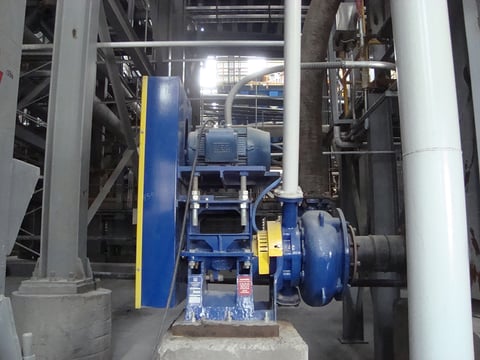
Pumps experience a wide variety of pressures and loads during operation, and it is important for operators to know how and when they occur. "Vane pass" is no exception. This term refers to the pressure pulsations generated within the pump as the impeller vanes pass the cutwater. Although this phenomenon is normal, it is important to understand as it can impact your pump and surrounding equipment. In this article, we examine the mechanics of vane pass and the potential problems it can cause, as well as provide recommendations for ensuring trouble-free operation.
Mechanics of vane pass
Vane pass is described by frequency and amplitude.
- Vane pass frequency (VPF): the number of times per minute that the rotating vane passes the cutwater. VPF is equal to the pump speed (in rotations per minute) times the number of impeller vanes.
- Vane pass amplitude (VPA): the magnitude of the pressure pulsation (low to high value) during one vane pass. This value depends on many factors — such as pump geometry and operating conditions — but is generally proportional to pump head. It tends to become larger as the number of vanes decreases, or as the pump operates at flows away from its best efficiency point.
Potential problems and solutions
Operators may observe high vibration if the vane pass frequency is close to a natural frequency of some other element in the pumping system, such as the foundation, drive train, surrounding piping, surrounding structures, or the pump itself. Although the resulting vibrations can cause a range of problems that are difficult to predict, measures can be taken in the design phase to prevent them. Common problems operators may experience include:
- Torsional resonance in the drive train: This can lead to over-stressing and fatigue failure in the rotating assembly. This failure can be difficult and costly to remedy, often requiring changes to the operational philosophy of the pump, or replacement of the impeller with one having a different number of impeller vanes. This can be avoided by conducting an FEM natural frequency analysis before finalizing the equipment design.
- Baseplate and/or foundation resonance: Foundations that are poorly supported, too flexible or too light, can lead to resonance of the baseplate or foundation. To avoid this, an FEM analysis should be done in the design phase. Installation of concrete, anchor tightening, and shimming should all be done according to design and under careful supervision since many foundation problems start there. For larger pumps, it is highly recommended to fill the baseplates with grout to add weight and stiffness, and to help ensure long-term stability.
- Piping resonance: Problems can occur when piping arrangements are under-supported. Although these arrangements can allow flexibility for expansion and other loads, they also can invite resonance at vane pass frequencies. If the measured vibration amplitude in the piping exceeds that in the pump, piping resonance due to overly flexible or inadequately supported piping is the most likely cause. To prevent this, add or strengthen piping supports and avoid design features that may react to vane pass, such as pipe elbows installed close to the pump, and long unsupported pipe sections.
- Vertical pump installations: Vertical pumps often have bearing assemblies and motors suspended above or next to the pump and/or long cantilever shafts leading to the wet end, and are, therefore, particularly subject to vibration problems. These installations should be examined carefully for resonance problems and steps taken whenever possible to reduce vane pass loading.

Minimizing vane pass
In addition to the preventive steps described above, several measures can be taken to reduce the impact of vane pass amplitude, along with any resulting vibrations.
- Choose pumps carefully so that actual operating conditions are within the optimal range close to the best efficiency point flowrate (BEPQ). Avoid flowrates below 50% BEPQ, whenever possible.
- Avoid using three-vane impellers for high head applications.
- Minimize the head per pump stage by adding booster pumps or reducing system resistance.
- Design the pump system — including the piping, support, and foundation — so that all natural frequencies are outside the expected VPF range, plus a reasonable safety factor of ±20%.
- Design pipe supports to handle the pressure pulsations and forces from vane pass and normal operating loads.
- Although pump systems can be designed to pass through a resonant frequency for a few seconds during startup or shutdown, this is not a recommended design practice for most applications. If it cannot be avoided, contact the pump manufacturer for advice before proceeding.
Vane pass pulsations occur in most types of centrifugal pumps. If aligned with resonant frequencies in the associated equipment, the resulting vibration can lead to damage across the system. Thankfully, most problems can be avoided by understanding the mechanics of vane pass and how it can impact surrounding structures, as well as by following good system design practices.
